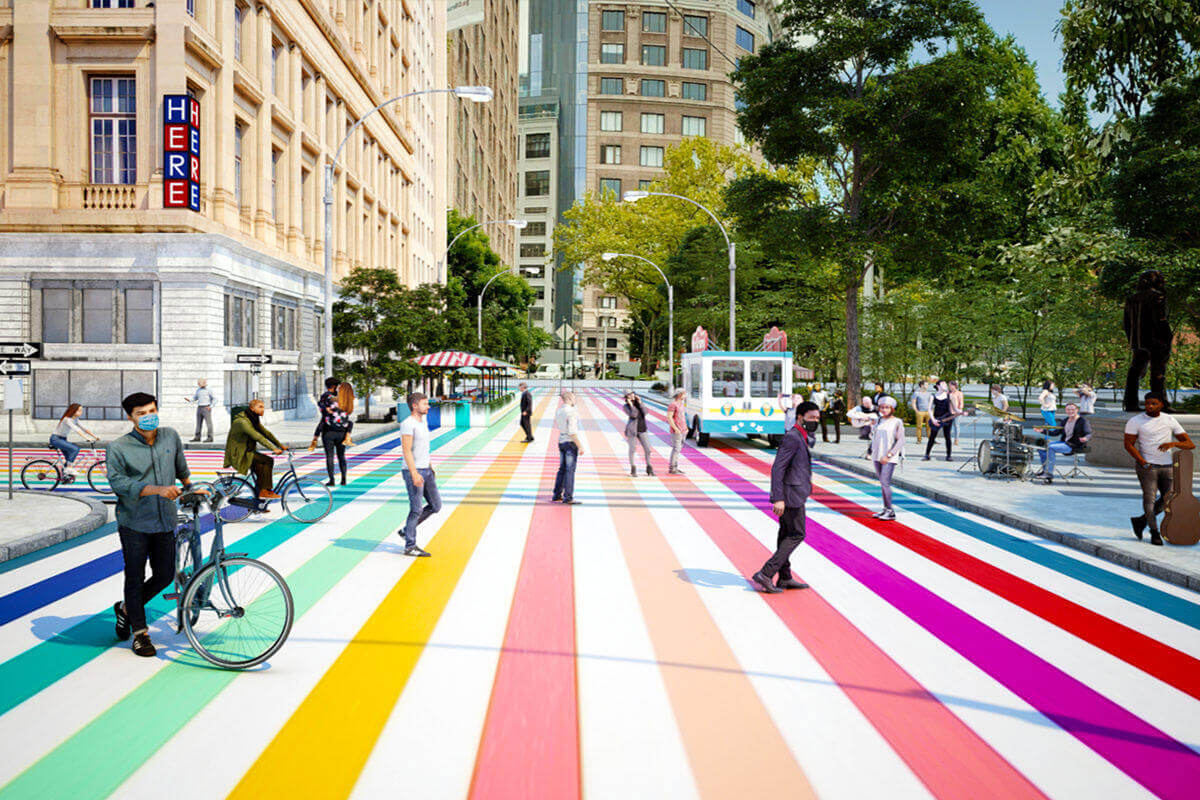

 Source: Marvel / Union Square Partnership
Source: Marvel / Union Square Partnership
A wholesale transformation of New York City’s public space from car-dominance to a variety of better uses will require a deliberate strategy around management and governance. To date, the work that New York City has done to convert car space into space for people has been largely project based, and most transformations were localized, one-off successes. The challenge for New York City’s next leaders will be how to scale recent successes citywide and holistically manage our public space. This is an admittedly large challenge and one that is necessary for New York’s next leaders to address head-on. But the overwhelming public support across demographics for all kinds of street improvements, and the urgency of our economic, health, traffic violence, equity and climate crises all add up to a broad mandate for change.
Because these kinds of interventions need to work on multiple scales — systemic improvements to our transportation network and targeted, community-specific improvements at the block level — New York City’s next leaders will need an integrated and interdisciplinary approach to management, community engagement, phasing, enforcement, and revenue. Transportation Alternatives challenges mayoral and City Council candidates to return a significant and sizable portion of car space to people, to do so with meaningful community engagement, and to implement, maintain and fund these projects with concrete and sustainable plans.
A holistic managerial approach to transforming city streets into a shared public space will require a new role in city government to manage the streets as a complicated inter-agency enterprise. This role will need to coordinate between city agencies such as the Department of Transportation, Parks Department, Department of Design and Construction and the Department of Education, among others, as well as outside partners and community groups. Most importantly, the role will need the authority to set priorities and allocate funding across agencies.
THREE KEY QUESTIONS
ADDITIONAL CONSIDERATIONS
These changes will require strong community partnerships and meaningful local engagement that transcends top-down decision making. Conversations around use of street space have long been divisive; community engagement around equitable reallocation of street space needs to be centered on a goal of healing. For certain components of this proposal — including the conversion of car parking spaces for on-street seating, the expansion of Open Streets, and the repurposing of school-adjacent streets — a committed, dedicated, and enthusiastic community partner can be essential to the successful implementation and ongoing success of the improvement.
THREE KEY QUESTIONS
ADDITIONAL CONSIDERATIONS
A reimagined streetscape and reinvigorated transit network can be the key to New York City’s recovery, but only with a solid strategy for funding and revenue generation. There are opportunities for direct revenue, such as the expansion of demand-based metered parking, which could bring in, by conservative estimates, more than $1 billion in revenue to the City of New York annually. Other tactics, such as the reinstatement of the New York City commuter tax, would create new sustainable revenue streams. There are also opportunities to leverage the private sector to create financial incentive programs to encourage transit use over driving.
THREE KEY QUESTIONS
ADDITIONAL CONSIDERATIONS
New safe streets and transportation infrastructure is only as good as the City’s willingness to ensure it is usable. This means enforcement — making sure bike lanes and bus lanes remain open and that dedicated freight zones are not used for unauthorized parking. But this must be done in a responsible, equitable, and safe way. In New York City, seven out of 10 likely voters support the idea of ending armed police traffic enforcement. The current enforcement of traffic laws by armed police puts New Yorkers, especially Black and Latino New Yorkers, at risk of police violence and is also a relatively ineffective method for making streets safe. Much of the budget once dedicated to police traffic enforcement could instead create self-enforcing streets. Fair and equitably placed automated enforcement, such as red light cameras and speed safety cameras, can fill in the gaps as self-enforcing streets are built citywide and as New York City drivers adjust to this new normal.
THREE KEY QUESTIONS
ADDITIONAL CONSIDERATIONS
Rebalancing streets away from cars and toward people will have an outsized impact in some neighborhoods. Communities that have suffered the most from disinvestment and neglect have the most to gain from the economic, environmental, public health, and public safety benefits of new open space and must be prioritized. Access to a new express bus in a car-free dedicated bus lane, for example, can provide a lifeline to an essential worker who would otherwise be out of range of the city’s public transit system. Similarly, adding open space in communities that are currently outside of a five-minute walk of a park or playground can have an immediate and lasting impact on health on individual and community levels.
THREE KEY QUESTIONS
ADDITIONAL CONSIDERATIONS
 Source: Scott Heins / TA
Source: Scott Heins / TA